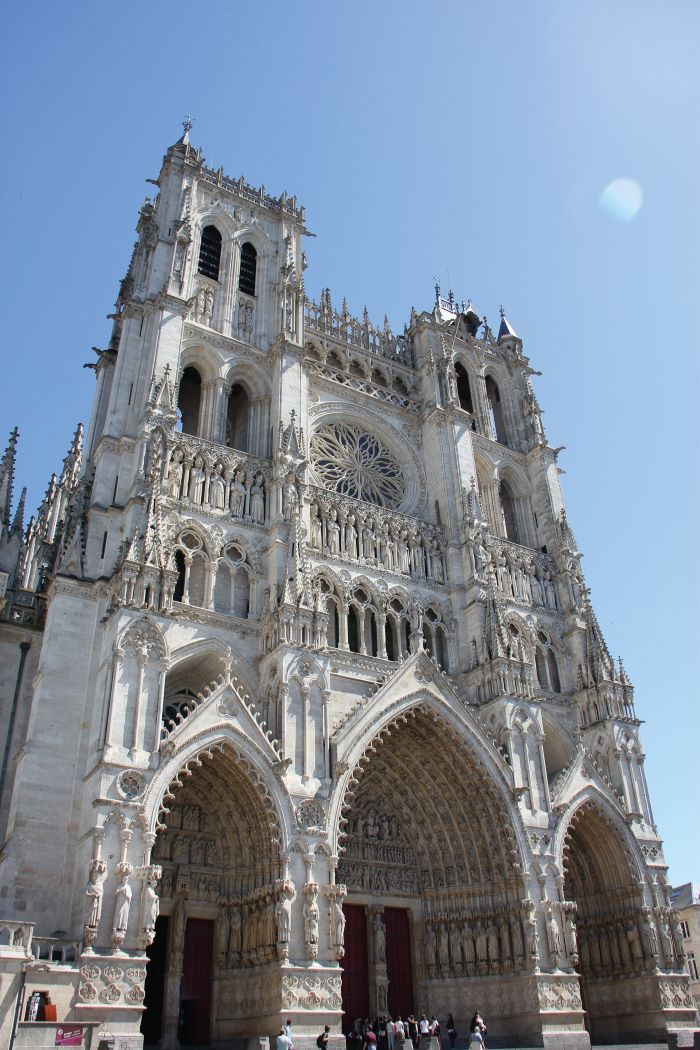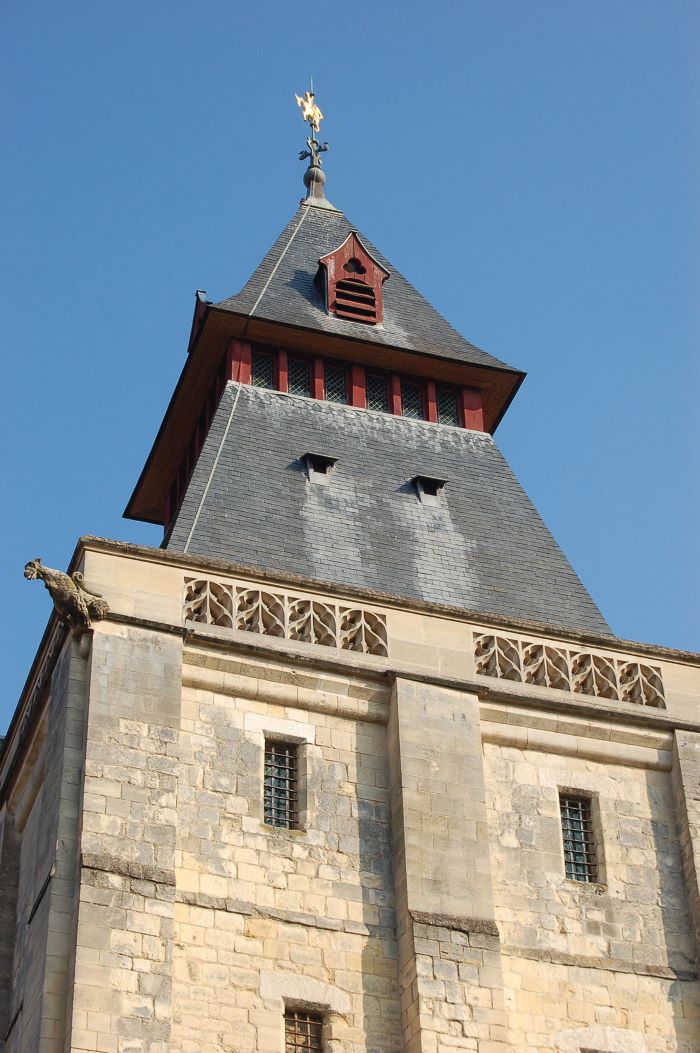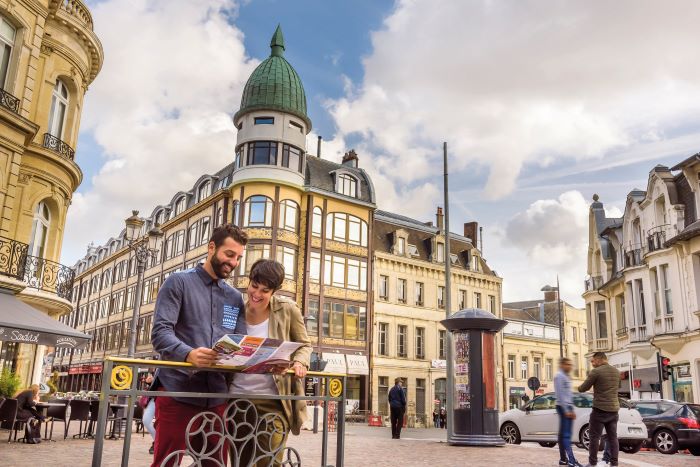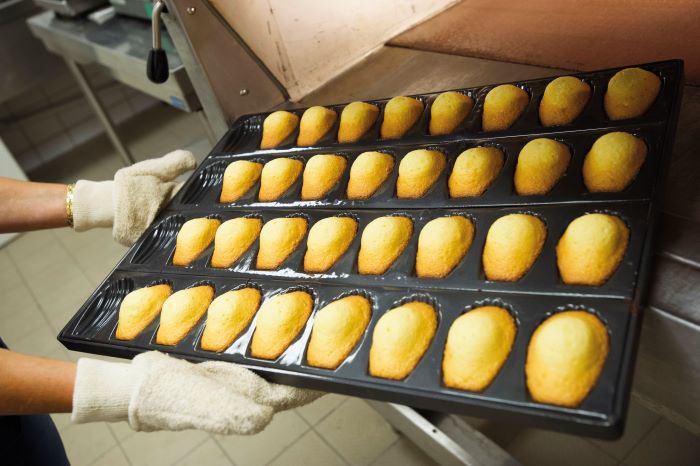Great Northern Road Trips

Yearning to hit the open French road and combine glorious sightseeing with super stays? The departments of Pas-de-Calais, Somme, Aisne and Meuse in Northeast France have everything you could wish for – easy to reach destinations for family escapes, friends or couples, with a broad choice of accommodation (from friendly gîte to high-end hotels and B&Bs) plus a riveting array of history, culture, food and drink. This is the best of France on your doorstep, with four self-drive itineraries, close to the quickest Cross-Channel route (ferry, Eurotunnel), and with easy access from Paris or Brussels.

Festivities in
Arras © C.BERGER
PAS-DE-CALAIS: CALAIS TO SAINT-OMER
The busy ferry port of Calais is so much more than an entry point for UK visitors – it is also ripe for exploration in its own right. Don’t miss the wood and steel animatronic behemoth, the 72-tonne Calais Dragon.
Admire its animatronic movements and fire breathing from a distance or if you’re feeling brave, climb up its tail to a covered panoramic platform saddled onto its winged back 10m above ground, for a hair-raising ride along the newly revamped seafront. Also unmissable is the fabulous lace and fashion museum.

First World War memorial Anneau de la mémoire in Ablain-Saint-Nazaire © Y CADART CD62
From Calais, head to the Grand Site de France Les Deux-Caps, a National natural protected area, by taking the D940 scenic coastal road rather than the A16 motorway. Explore the dunes, beaches, cliffs, fishing villages and Atlantic Wall World War II fortifications – the area is perfect for hiking or bike rides, including the brand new Vélomaritime itinerary, while you can best spot the White Cliffs of Dover in the morning.
Next stop: Boulogne-sur-Mer. Take a stroll in the old town, wander along on the ramparts and visit Nausicaa, the largest aquarium in Europe. And be wowed by the largest crypt in France, located underneath the Notre-Dame Basilica. The town is also heaven for seafood restaurant lovers.

Cap Blanc Nez hiking © E. Desaunois
About 40 minutes south is Montreuil-sur-Mer, a small countryside town with charming cobbled streets and compelling independent shops. Gourmands will relish a visit too: this “Destination Gastronomique” has a lively foodie scene, from simple restaurants to the two Michelin-starred La Grenouillère.
From Montreuil you can easily visit seaside stunner Le Touquet to the west and the rivers and forests of the picturesque Seven Valleys to the east.

leave the open road and enjoy travelling via waterways ©HORIZONBLEU, PIDZ, OFFICE DE TOURISME CALAIS CÔ TE D’OPALE, E. DESAUNOIS; A-S FLAMENT
Love architecture? The eye-pleasing UNESCO-listed town hall, belfry and citadel in Arras will do the trick. Soak up the ambiance in the two central squares with their iconic façades and many bar and restaurant terrasses, before descending into World War I history at the remarkable Wellington Tunnels.
Of the many must-visit cemeteries, memorials and museums are the CWGC Experience and, en route to Lens, Notre-Dame-de-Lorette and the Ring of Remembrance, and Memorial 14-18, plus the beautiful and humbling Canadian National memorial at Vimy Ridge.

the memorial at Vimy ©PIDZ
In the former coal mining town of Lens, the Louvre-Lens offers another way of visiting the Louvre, but without the crowds – explore its three exhibition areas, including the Gallery of Time featuring 250 masterpieces from the Louvre in Paris, displayed in a chronological order.
The next recommended stopover is Béthune, with its Art Deco square and renovated belfry (climb it to admire the eclectic façades all around). The town also has some great boutiques and foodie shops, plus a contemporary arts museum and a walking trail detailing Béthune’s British occupation during World War I.

you’ll be spoilt for choice when it comes to dining out in Le Touquet © A-S FLAMENT
The final stop on the Pas-de-Calais tour is Saint-Omer, with its UNESCO-listed marshes and biosphere nature reserve, great for birdwatching or a relaxing boat tour (by barge in a group or in a self drive, electric-propelled wooden boat). Pop to the La Maison du Marais to learn all about the area.
Also compelling: the town’s Saturday market, Gothic cathedral and nearby, le Palais de la Cathédrale is a private house that can be visited, beautifully maintained in its historic condition.
Follow this itinerary on Google Maps: https://bit.ly/331L2QZ
For more on visiting Pas-de-Calais, see: visit-pas-de-calais.com

Château de Long, a pink brick and white stone beauty ©, SOMME TOURISME
THE SOMME: BAIE DE LA SOMME TO PÉRONNE
No visit to the Somme department is complete without exploring the natural beauty of La Baie de la Somme, a “Grand Site de France”. Enjoy a wander – with or without a tour guide – through vast open spaces, exploring beaches, sand banks and walking trails. Skippered boat trips are a great way to explore too, such as the Saint-Valery-sur-Somme to Cap Hornu round trip. This is one of France’s important stopover sites for migratory birds – head for the Marquenterre nature reserve for serious bird-spotting.

The world-famous Amiens Cathedral © R.LeBideau
Historic Abbeville, dubbed the gateway to the Somme Bay, is super for exploring by foot. For your checklist: the “Musée de France” Boucher de Perthes Museum, next to the town’s UNESCO belfry (built in 1209), and home to some of the prehistory discoveries by the town’s most famous son, Jacques Boucher de Perthes. And don’t miss Émonville Park or Saint Vulfran’s collegiate church, a flamboyant Gothic masterpiece.
Next stop, 16km southeast of Abbeville: Château de Long, an 18th-century beauty in pink brick and white stone with a Mansard roof, built during the reign of King Louis XV. Inside, admire its sculpted décor and paintings by Huet then stroll around its 20 hectares of grounds with listed greenhouses, wash house, 18th-century dovecote, orangery and ice house.

LV Hortillonnages ©SommeTourisme
Somme capital Amiens is a wonderful city break destination, easy to explore with many must-sees: a resplendent UNESCO-listed Gothic cathedral (whose evening sound and light shows are truly special); Jules Verne’s home (Maison de la Tour, now a dazzlingly imaginative museum), a buzzing night-time ambiance (the regenerated Saint-Leu district is both lively and pretty), plus the famous water gardens, Les Hortillonnages. The city has great shops and restaurants too, plus it is compact, giving a village feel.

LaBoisselle©SommeTourisme-Garry
Head east from Amiens to Corbie, with its sublime Abbatiale Saint-Pierre. This Neo-Gothic building, famed for it impressive façade, stands as one of the last witnesses of the powerful Benedictine abbey of Corbie, whose influence spread all over Europe. The church houses a number of treasured relics and statues – and one of the fingers of Saint Peter of Rome, an apostle of Jesus and the very first Pope!
Of course, the Somme is forever linked to the Great War, and the battlefield remains of trenches and shellholes, plus many cemeteries and memorials are a permanent reminder of the unthinkable price the area paid in human and material loss. The excellent, poppy-peppered Remembrance Trail, a circuit linking Albert and Péronne, two symbolic towns of the Great War, allows visitors to discover the main sites of remembrance on the Western Front in the Somme.

Musée Boucher-de Perthes at Abbeville © SommeTourisme
Essential visits include Thiepval Memorial and the Museum of Thiepval, the Somme 1916 Museum in Albert, the Newfoundland Memorial at Beaumont-Hamel, the Lochnagar Crater at La Boisselle, the Australian National Memorial at Villers-Bretonneux and the Sir John Monash Centre.
A standout museum is the Historial Museum of the Great War in Péronne, a town occupied by the Germans for almost the entire duration of the war.

The belfry at Abbeville © SommeTourisme
Wide-ranging and expertly conceived, the museum guides visitors using a 360-degree perspective, with a timeline from pre- to post-war (1870 to the 1930s), elements from the ‘home front’ (18,000 objects in total, about 5% exhibited at any one time), uniforms and propoganda items.
Follow this itinerary on Google Maps: http://bit.ly/somme-maps
For more on visiting Somme, see: www.visit-somme.com

Familistere © Horizon_Bleu
AISNE: SAINT-QUENTIN TO VIELS-MAISONS
Using historic Laon (more of which later) as your base, here are two looped itineraries to enjoy in the Aisne department. The first takes us north – first stop, Saint-Quentin.
80% destroyed during the Great War, the town’s subsequent rebirth, architecturally speaking, saw an abundance of fine art deco edifices built during the 1920s. On the main square, spy brightly-coloured beauties in Flamand and Baroque styles. Elsewhere, don’t miss the Hôtel de Ville (1509), its Flamboyant Gothic exterior featuring 173 sculptures and chiming carillon bells. Most eye-catching inside: the magnificent Louis Guindez-designed Art Deco wood- and ironwork room, which is now used for local council meetings.

The breathtaking Cathedral at Laon © colin
Elsewhere, La Réserve Naturelle Nationale des Marais d’Isle – a nature reserve and watery oasis in the town centre that can be explored by bacove (small boat) – is unique in France. You can even sqim at its beach.
Due East from Saint-Quentin is Guise, home to the amazing Le Familistère de Guise. Known as the “People’s Palace”, it was built between 1859 to 1884 by Jean-Baptiste André Godin near his cast-iron stove factory, to provide housing for 2,000 residents. Deemed one of the most ambitious social experiments of the industrialised world, it even had its own theatre. Today it is a fascinating museum exploring the Utopian reformer’s remarkable vision and ideals.

Picnic amongst the vines © cambon
You can also take in Guise’s fortified castle, while cyclists can ride the EuroVelo3 route to discover fortified churches.
From Guise, loop back south to Laon, sitting majestically atop the ‘Montagne Couronnée’ (Crowned Mountain).
Laon boasts 83 historical monuments including the stunning Notre-Dame cathedral, one of the first ‘primitive Gothic’ cathedrals in the world (you can climb up to the top of the tower); the exceptional underground passages; its fortified gates, and a Templars’ chapel.

Saint Quentin is great for sightseeinhg on foot © cambon
You can shop and eat very well too here – try the local Picardy speciality, ficelle Picarde, a ham and mushroom pancake baked with cheese.
South of Laon is a remarkable Great War site, the Caverne du Dragon (The Dragon’s Lair) which sits on the Western Front’s strategic stronghold, the Chemin des Dames (The Ladies’ Way). An underground quarry that served as a barracks for both French and German soldiers, today it hosts guided tours deep into the cave network, to reveal the former field hospitals and command posts.

The Abbaye Saint-Jean-des-Vignes © cambon
British losses locally were heavy in September 1914 – 728 of the fallen lie at Vendresse Cemetery, while the First World War Rugby Memorial, inaugurated in 2017, honours British ‘rugbymen’ killed in action.
In Soissons, visit the Abbey of Saint-Jean-des-Vignes with its 75m-high spires. Founded in the 11th century, it is one of the most important Augustine abbeys in the north of France. Although only the elegant façade remains, the monks’ refectory, cloister and outbuildings remain intact. Learn all about the abbey’s history at the excellent Centre for the Interpretation of Architecture and Heritage.

Jardins viels maisons ©cambon
Aisne is a great destination for fans of the fizzy stuff: it makes around 10% of the country’s Champagne and across the department small viticulteurs open up their cellars and vineyards for tours (or simply enjoy a picnic or bike ride). For example, head to Champagne Méteyer Père & Fils, in Trélou-sur-Marne in the heart of the Marne Valley, to enjoy a vineyard visit in a classic old Citroën Diane and a dégustation masterclass.

Monument Basque © H.Balesse
Still on a wine theme, the Château de Condé-en-Brie – called “The Princes’ Château” – is a splendid castle in the heart of the vineyards, famous for its superb paintings by Oudry, Watteau, Lancret and striking original decorations by Italian decorator Servandoni – preserved in situ since the 18th century. A great place for children to enjoy.

Chapelle Cerny en Laonnois © Caroline-Choain
The fragrant last stop on the Aisne tour is the marvellous Gardens of Viels-Maisons, one of the most beautiful gardens in the whole of the Hauts-de-France region. This ‘Jardin Remarquable’ is a horticulture lover’s paradise, featuring an English garden, arose garden, an arboretum garden and a botanical garden.
Itinerary maps: Northern tour: http://bit.ly/nord-saint-quentin Southern tour: http://bit.ly/sud-chateau-thierry
For more on visiting Aisne, see: bit.ly/3uF4L5k

Montsec Memorial © Guillaume Ramon
MEUSE: ROMAGNE TO BAR-LE-DUC
Our Meuse road trip takes us from north to south, starting with two important American World War One remembrance sites.
Located in Romagne, the Meuse-Argonne American Cemetery and Memorial covers 130.5 acres, on which are laid to rest the largest number of US military dead in Europe, 14,246 in total. A few kilometres south of here is the Montfaucon American Monument, a huge granite doric column commemorating the American First Army’s victory during the Meuse Argonne Offensive in autumn 1918. Both are tranquil, touching places to pay respects to America’s fallen.

Meuse-Argonne American © Guillaume Ramon
Next, head to Verdun, a charming town with 30 centuries of history but sadly known for the longest battle of WWI. In the town itself, check out the huge Monument à la Victoire (Monument to Victory) and renewed visitors’ route in the Citadelle souterraine (Underground citadel), while in summer try to catch the spectacular son-et-lumière show, a dramatic staged account of the Battle of Verdun called “From Flames to the Light”.
The Great War’s Verdun battlefield, the scene of a 300-day, 300-night battle in 1916, has some of the most essential historic sites in France. The quite exceptional Verdun Memorial museum comprises, over three floors: a concise historical background to the war; a replica (noises and all) of the 1916 battlefield set within a glass cage; and everyday objects used by soldiers such as mess tins and cigarette packets. As ‘big ticket’ museums go, it is singular.

Douaumont is a must on the remembrance trail © Guillaume Ramon
Next, to Douaumont, where an enormous ossuary shelters the remains of 130,000 unknown French and German soldiers. The 137m long cloister has 42 interior alcoves, while the climbable tower is 46m high. Captivating is the 20-minute film (available in English) shown there: “Verdun des hommes de boue” (Verdun, Men in Mud).

sweet treats include Mirabelle plums and madeleines © Guillaume Ramon
Nearby, the mighty Fort de Douaumont was captured four days into the Battle of Verdun by the Germans, who used it to house troops before it was recaptured in October 1916. You can wander the cold, damp corridors and see a 155mm turreted gun, barracks, historical films, photographs and use detailed multimedia guides.
Heading back past Verdun, we reach the verdant Côtes de Meuse (Meuse Hills) area around Hattonchâtel, the growing hub for the department’s iconic fruit, the Mirabelle plum, as a well some intriguing wines. The area is all about getting back to nature, be it fishing on the largest lake in Lorraine or visiting fruit farms. And don’t miss, on a hilltop overlooking orchards and vineyards, the medieval Hattonchâtel Castle that has been rebuilt thanks to the American benefactor Belle Skinner. Continue on to discover Saint-Mihiel, birthplace of Ligier Richier, Lorraine’s greatest Renaissance artist.

Old world charm at Hattonchatel © Guillaume Ramon
Further due south, make a solemn pause at the colonnaded Montsec American memorial, erected in 1932. It commemorates troops killed in the liberation of the famed Saint-Mihiel salient (‘bulge’ or a piece of land that juts out) in September 1918. Located 377m high up on the Butte de Montsec, it provides a fine panoramic view over Lake Madine and the Meuse Hills. Commercy, southwest of Montsec, is all about cakes – Proust’s memory-tripping madeleines to be precise. According to legend, its name comes from a young servant girl working at the Château de Commercy – home of the Duke of Lorraine (Stanislas Leszczynski, stepfather of Louis XV) in 1755. The pastry chef had stormed off
following an argument, so the maid invented the small cakes for her boss, who named them after her: Madeleine. Snap some up at one of the town’s specialist bakeries.

Madeleine © Guillaume Ramon
The last stop on our Meuse road trip is magnificent Bar-le-Duc, the Meuse capital boasting a prestigious Ville d’art et d’histoire label. The upper town features some of the most beautiful Renaissance architecture in France – spot elegant private mansion before heading to Place Saint-Pierre, home to the Flamboyant Gothic Saint-Etienne. Herein sit two of the most striking works by Ligier Richier – “Calvary” (Le calvaire) depicting Christ and the two thieves and, even more spectacular, “The Corpse” (Le transi).
While in Bar-le-Duc, grab some luxurious redcurrant ‘caviar’ (confiture de groseilles), made painstakingly by hand – the seeds are removed using a goose feather!). It’s the perfect edible memento of Meuse
to take home!
Itinerary map http://bit.ly/roadtrip-meuse
For more on visiting Meuse, see: wwww.lameuse.fr
From France Today Magazine
Share to: Facebook Twitter LinkedIn Email
More in car rides, cycling, explore, peugeot cars, remembrance, roadtrip, walking trails
Leave a reply
Your email address will not be published. Required fields are marked *



